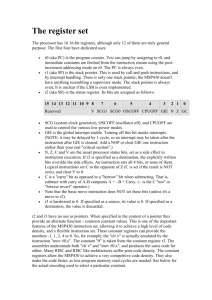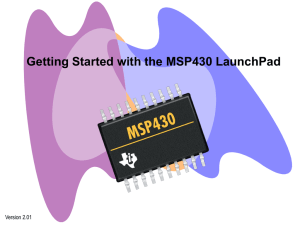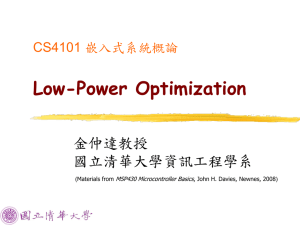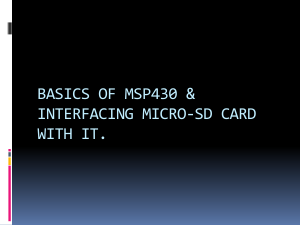Launchpad Introduction from TI
advertisement
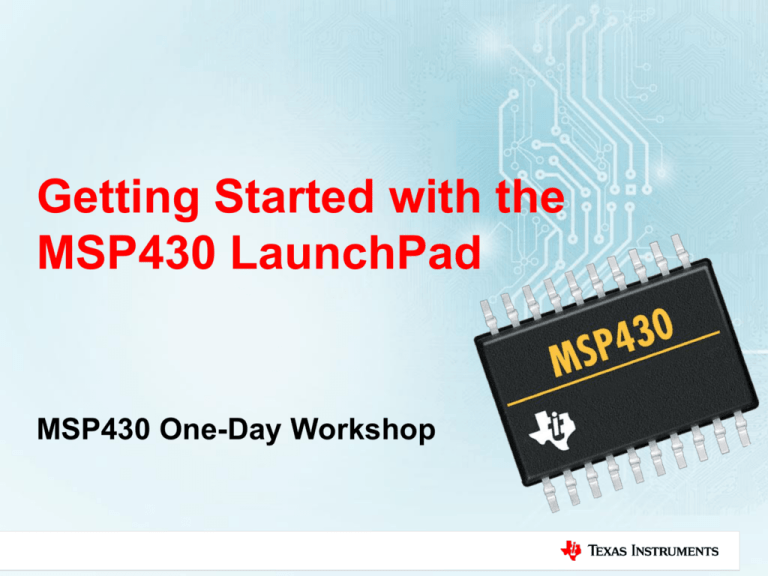
Getting Started with the
MSP430 LaunchPad
MSP430 One-Day Workshop
Workshop Agenda
► Introduction to Value Line
Code Composer Studio
Initialization and GPIO
Analog-to-Digital Converter
Interrupts and the Timer
Low-Power Optimization
Serial Communications
Grace
FRAM
Capacitive Touch
Using Energia (Arduino)
http://www.ti.com/msp430
Microcontrollers
(MCU)Processor
Application
(MPU)
TI’s Embedded
Portfolio
MSP430
C2000
Tiva
Hercules
Sitara
DSP
Multicore
16-bit
Ultra Low
Power & Cost
32-bit
32-bit
All-around
MCU
32-bit
32-bit
Linux
Android
16/32-bit
All-around
DSP
32-bit
Massive
Performance
ARM
Cortex-A8
Cortex-A9
DSP
C5000
C6000
• C66 + C66
• A15 + C66
• A8 + C64
• ARM9 + C674
MSP430
ULP RISC
MCU
• Low Pwr Mode
0.1 µA
0.5 µA (RTC)
• Analog I/F
• RF430
Real-time
• Real-time
ARM
C28x MCU Cortex-M3
• ARM M3+C28 Cortex-M4F
Safety
ARM
Cortex-M3
Cortex-R4
• Motor Control • 32-bit Float
• Lock step
• $5 Linux CPU • C5000 Low
•
Nested
Vector
Dual-core
R4
Power DSP
• Digital Power
IntCtrl (NVIC) • ECC Memory • 3D Graphics
• 32-bit fix/float
• Precision
• PRU-ICSS
•
Ethernet
industrial subsys C6000 DSP
Timers/PWM
(MAC+PHY) • SIL3 Certified
Linux, Android, C5x: DSP/BIOS
SYS/BIOS
C6x: SYS/BIOS
• Fix or Float
• Up to 12 cores
4 A15 + 8 C66x
• DSP MMAC’s:
352,000
TI RTOS
(SYS/BIOS)
TI RTOS
(SYS/BIOS)
TI RTOS
(SYS/BIOS)
N/A
Linux
SYS/BIOS
Flash: 512K
FRAM: 64K
512K
Flash
512K
Flash
256K to 3M
Flash
L1: 32K x 2
L2: 256K
L1: 32K x 2
L2: 256K
L1: 32K x 2
L2: 1M + 4M
25 MHz
300 MHz
80 MHz
220 MHz
1.35 GHz
800 MHz
1.4 GHz
$0.25 to
$9.00
$1.85 to
$20.00
$1.00 to
$8.00
$5.00 to
$30.00
$5.00 to
$25.00
$2.00 to
$25.00
$30.00 to
$225.00
MSP430 Released Devices
Value Line Parts
Power consumption @ 2.2V:
• 0.1 μA RAM retention
• 0.4 μA Standby mode (VLO)
• 0.7 μA real-time clock mode
• 220 μA / MIPS active
• Ultra-Fast Wake-Up From Standby Mode in <1 μs
MSP430 CPU
R0 / PC (Program Counter)
Extended addressing modes
No paging
Page-free 20-bit reach
Improved code density
Faster execution
Full tools support through
IAR and CCS
R2
R2 / CG1
R3
R3 / CG2
R4
R4
R5
R5
R6
R6
R7
R7
R8
R8
R9
R9
R10
R10
R11
R11
R12
R12
R13
R13
R14
R14
R15
R15
16-bit Data
100% code compatible with
earlier versions
1MB unified memory map
20-bit Address
R1 / SP (Stack Pointer)
Memory Map
Flash programmable via JTAG or
In-System (ISP)
ISP down to 2.2V. Single-byte or
Word
Interruptible ISP/Erase
Main memory: 512 byte segments
(0-n). Erasable individually or all
Information memory: 64 byte
segments (A-D)
Section A contains device-specific
calibration data and is lockable
Programmable Flash Memory
Timing Generator
MSP430G2553 shown
0FFFFh Interupt Vector Table
0FFE0h
Flash
FFDFh
0C000h
010FFh
01000h
03FFh
0200h
01FFh
0100h
0FFh
010h
0Fh
0h
Information
Memory
RAM
16-bit
Peripherals
8-bit
Peripherals
8-bit Special
Function
Registers
Value Line Peripherals
General Purpose I/O
16-bit Timer_A2 or A3
2/3 capture/compare registers
Extensive interrupt capabilities
WDT+ Watchdog Timer
Independently programmable
Any combination of input, output, and interrupt (edge
selectable) is possible
Read/write access to port-control registers is supported by
all instructions
Each I/O has an individually programmable pull-up/pull-down
resistor
Some parts/pins are touch-sense enabled (PinOsc)
Also available as an interval timer
Brownout Reset
Provides correct reset signal during power up and down
Power consumption included in baseline current draw
Value Line Peripherals
Serial Communication
Comparator_A+
USI with I2C and SPI support
USCI with I2C, SPI and UART support
Inverting and non-inverting inputs
Selectable RC output filter
Output to Timer_A2 capture input
Interrupt capability
8 Channel/10-bit 200 ksps SAR ADC
8 external channels (device dependent)
Voltage and Internal temperature sensors
Programmable reference
Direct transfer controller send results to conversion memory
without CPU intervention
Interrupt capable
Some parts have a slope converter
LaunchPad Development Board
USB Emulator
Connection
Embedded Emulation
• 16kB Flash
6-pin eZ430
Connector
• 512B RAM
• 2 Timer_A3’s
• 8 Ch. Comp_A+
• 8 Ch. ADC10
• USCI
Crystal Pads
Chip
Pinouts
P1.3 Button
LEDs and Jumpers
P1.0 & P1.6
Part and Socket
Power Connector
Reset Button
Lab1: Hardware Setup
• Download and install tools
and documentation
• Review kit contents
• Connect hardware
• Test preloaded software
Workshop Agenda
Introduction to Value Line
► Code Composer Studio
Initialization and GPIO
Analog-to-Digital Converter
Interrupts and the Timer
Low-Power Optimization
Serial Communications
Grace
FRAM
Capacitive Touch
Using Energia (Arduino)
http://www.ti.com/msp430
What is Code Composer Studio?
Integrated development environment for TI embedded processors
Includes debugger, compiler, editor, simulator, OS…
The IDE is built on the Eclipse open source software framework
Extended by TI to support device capabilities
CCSv5 is based on “off the shelf” Eclipse (version 3.7 in CCS 5.1)
Future CCS versions will use unmodified versions of Eclipse
Drop in Eclipse plug-ins from other vendors or take TI tools and drop them
into an existing Eclipse environment
Users can take advantage of all the latest improvements in Eclipse
Integrate additional tools
TI contributes changes directly to the open source community
OS application development tools (Linux, Android…)
Code analysis, source control…
Linux support soon
Low cost! $445 or $495
User Interface Modes
Simple Mode
Advanced Mode
By default CCS will open in simple/basic mode
Simplified user interface with far fewer menu items, toolbar buttons
TI supplied Edit and Debug Perspectives
Uses default Eclipse perspectives
Very similar to what exists in CCSv4
Recommended for users who will be integrating other Eclipse based
tools into CCS
Possible to switch Modes
Users can decide that they are ready to move from simple to advanced
mode or vice versa
Common tasks
Creating New Projects
Build options
Very simple to create a new project for a device using a template
Many users have difficulty using the build options dialog and find it
overwhelming
Updates to options are delivered via compiler releases and not
dependent on CCS updates
Sharing projects
Easy for users to share projects, including working with version
control (portable projects)
Setting up linked resources has been simplified
Workspaces and Projects
Workspace
Project 1
Link
Project 2
Project 3
Settings and preferences
Project
Project
Project
Source
files
Link
Source files
Source
Header
filesfiles
Link
Header Files
Header
Library
filesFiles
Library files
Library
filessettings
Build
and tool
Build and tool settings Link
Build and tool settings
Source files
Code and Data
Header files
Declarations/Defines
Library files
Code and Data
A workspace contains
your settings and
preferences, as well as
links to your projects.
Deleting projects from
the workspace deletes
the links, not the files
A project contains
your build and tool
settings, as well as
links to your input
files.
Deleting files from the
workspace deletes the
links, not the files
Project Wizard
Single page wizard for majority of
users
Debugger setup included
Next button will show up if a template
requires additional settings
If a specific device is selected, then
user can also choose their
connection, ccxml file will be created
Simple by default
Compiler version, endianness… are
under advanced settings
Adding Files to Projects
Add Files to Project allows
users to control how the file
is added to the project
Linking Files using built-in
macros allows easy creation
of portable projects
IAR Kickstart
4kB Compiler
Supports all MSP430 variants
Assembler/Linker
Editor
Debugger
Accessing MSP430 Features
1.
Device specific header file
2.
Device specific linker command file
3.
Symbols defined for bit fields, reg’s, etc.
Structs/union’s also defined for bit fields, if you prefer
You shouldn’t have to use hard-coded bit locations, etc.
Device specific addresses defined in dev specific .cmd file
Creating a new CCS project automatically includes a project
.cmd file … which includes the device specific .cmd file
You shouldn’t have to ever look up the address of a register
C Compiler Intrinsic Functions
Access device/assembly specific features using built-in C
functions
Intrinsics for MSP430 C Compiler
_bcd_add_short();
_bcd_add_long();
_bic_SR_register();
_bic_SR_register_on_exit();
_bis_SR_register();
_bis_SR_register_on_exit();
_data16_read_addr();
_data16_write_addr ();
_data20_read_char();
_data20_read_long();
_data20_read_short();
_data20_write_char();
_data20_write_long();
_data20_write_short();
_delay_cycles();
_disable_interrupt();
_never_executed();
_enable_interrupt();
_no_operation();
_even_in_range();
_op_code();
_get_interrupt_state();
_set_interrupt_state();
_get_R4_register();
_set_R4_register();
_get_R5_register();
_set_R5_register();
_get_SP_register();
_set_SP_register();
_get_SR_register();
_swap_bytes();
_get_SR_register_on_exit();
_low_power_mode_0();
_low_power_mode_1();
_low_power_mode_2();
_low_power_mode_3();
_low_power_mode_4();
_low_power_mode_off_on_exit();
Lab2: Code Composer Studio
• Lab
•Re-create temperature sense demo
•Program part and test
•Close Grace pane
•Optional
• Add microcrystal to board
• Program part to test crystal
Workshop Agenda
Introduction to Value Line
Code Composer Studio
► Initialization and GPIO
Analog-to-Digital Converter
Interrupts and the Timer
Low-Power Optimization
Serial Communications
Grace
FRAM
Capacitive Touch
Using Energia (Arduino)
http://www.ti.com/msp430
System State at Reset
At power-up (PUC), the brownout circuitry holds device in reset until
Vcc is above hysteresis point
RST/NMI pin is configured as reset
I/O pins are configured as inputs
Clocks are configured
Peripheral modules and registers are initialized (see user guide for
specifics)
Status register (SR) is reset
Watchdog timer powers up active in watchdog mode
Program counter (PC) is loaded with address contained at reset vector
location (0FFFEh). If the reset vector content is 0FFFFh, the device will
be disabled for minimum power consumption
Software Initialization
After a system reset the software must:
Initialize the stack pointer (SP), usually to the top of
RAM
Reconfigure clocks (if desired)
Initialize the watchdog timer to the requirements of
the application, usually OFF for debugging
Configure peripheral modules
Clock System
Very Low Power/Low Frequency
Oscillator (VLO)*
4 – 20kHz (typical 12kHz)
500nA standby
0.5%/°C and 4%/Volt drift
Not in ’21x1 devices
Crystal oscillator (LFXT1)
Programmable capacitors
Failsafe OSC_Fault
Minimum pulse filter
Digitally Controlled Oscillator
(DCO)
0-to-16MHz
+ 3% tolerance
Factory calibration in Flash
* Not on all devices. Check the datasheet
VLO
Min. Puls
Filter
ACLK
Peripherals
OSC_Fault
16MHz
DCO
MCLK
CPU
SMCLK
Peripherals
On PUC, MCLK and SMCLK are
sourced from DCOCLK at ~1.1 MHz.
ACLK is sourced from LFXT1CLK in
LF mode with an internal load
capacitance of 6pF. If LFXT1 fails,
ACLK defaults to VLO.
G2xxx - No Crystal Required DCO
// Setting the DCO to 1MHz
if (CALBC1_1MHZ ==0xFF || CALDCO_1MHZ == 0xFF)
while(1);
// Erased calibration data? Trap!
BCSCTL1 = CALBC1_1MHZ;
// Set range
DCOCTL
// Set DCO step + modulation
= CALDCO_1MHZ;
G2xx1 devices have 1MHz DCO constants only. Higher frequencies must be
manually calibrated
G2xx2 & G2xx3 (like the G2553) have all 4 constants + calibration values for the
ADC & temperature sensor
Run Time Calibration of the VLO
Calibrated 1 MHz DCO
TAR
fVLO = 8MHz/Counts
CCRx
ACLK/8 from VLO
Calibrate the VLO during runtime
Clock Timer_A runs on calibrated 1MHz DCO
Capture with rising edge of ACLK/8 from VLO
fVLO = 8MHz/Counts
Code library on the web (SLAA340)
System MCLK & Vcc
Match needed clock speed with required Vcc to achieve the lowest power
External LDO regulator required
Unreliable execution results if Vcc < the minimum required for the selected frequency
All G2xxx device operate up to 16MHz
Watchdog Timer Failsafe Operation
If ACLK / SMCLK fail, clock
source = MCLK
(WDT+ fail safe feature)
If MCLK is sourced from a
crystal, and the crystal
fails, MCLK = DCO
(XTAL fail safe feature)
16-bit
Counter
CLK
MCLK
Fail-Safe
Logic
SMCLK
1
ACLK
1
WDTSSEL
A
EN
WDTHOLD
Watchdog Timer Clock Source
WDTCTL (16-Bit)
WDTHOLD
WDTNMIES
WDTNMI
WDTTMSEL
WDTCNTCL
Clock
Request
Logic
MCLK Active
SMCLK Active
ACLK Active
WDTSSEL
WDTIS1
WDTIS0
Active clock source cannot be disabled (WDT mode)
May affect LPMx behavior & current consumption
WDT(+) always powers up active
Lab3: Initialization
• Write initialization code
• Run CPU on MCLK sourced by:
• VLO
• 32768 crystal
• DCO
• Program part
• Observe LED flash speed
Workshop Agenda
Introduction to Value Line
Code Composer Studio
Initialization and GPIO
► Analog-to-Digital Converter
Interrupts and the Timer
Low-Power Optimization
Serial Communications
Grace
FRAM
Capacitive Touch
Using Energia (Arduino)
http://www.ti.com/msp430
Fast Flexible ADC10
10-bit 8 channel SAR ADC
200 ksps+
Selectable conversion clock
Autoscan
6 external channels
Vcc and internal temperature
Single
Sequence
Repeat-single
Repeat-sequence
Internal or External reference
Timer-A triggers
Interrupt capable
Data Transfer Controller (DTC)
Auto power-down
1.5V or 2.5V
Auto
AVSS
S/H
AVCC
VRVR+
10-bit SAR
ADC10SC
TA1
TA0
TA2
Batt Temp
Direct
Data
Transfer
Transfer
Controller
Controller
RAM, Flash,
Peripherals
Sample Timing
Reference must settle for <30uS
Selectable hold time
13 clock conversion process
Selectable clock source
- ADC10OSC (~5MHz)
- ACLK
- MCLK
- SMCLK
AUTO
Autoscan + DTC Performance Boost
ADC
DTC
// Software
Res[pRes++] = ADC10MEM;
ADC10CTL0 &= ~ENC;
if (pRes < NR_CONV)
{
CurrINCH++;
if (CurrINCH == 3)
CurrINCH = 0;
ADC10CTL1 &= ~INCH_3;
ADC10CTL1 |= CurrINCH;
ADC10CTL0 |= ENC+ADC10SC;
}
70 Cycles / Sample
Data2
Data1
Data0
Data2
// Autoscan + DTC
_BIS_SR(CPUOFF);
Fully Automatic
Lab4: ADC
• Measure internal temperature
• Set timing requirements
• Additional CCS features
Workshop Agenda
Introduction to Value Line
Code Composer Studio
Initialization and GPIO
Analog-to-Digital Converter
► Interrupts and the Timer
Low-Power Optimization
Serial Communications
Grace
FRAM
Capacitive Touch
Using Energia (Arduino)
http://www.ti.com/msp430
Timer_A2 and A3 Features
Asynchronous 16-bit
timer/counter
Continuous, up-down,
up count modes
2 or 3 capture/compare
registers
PWM outputs
Two interrupt vectors
for fast decoding
Interrupts and the Stack
Entering Interrupts
Any currently executing instruction is completed
The PC, which points to the next instruction, is pushed onto the stack
The SR is pushed onto the stack
The interrupt with the highest priority is selected
The interrupt request flag resets automatically on single-source flags;
Multiple source flags remain set for servicing by software
The SR is cleared; This terminates any low-power mode; Because the
GIE bit is cleared, further interrupts are disabled
The content of the interrupt vector is loaded into the PC; the program
continues with the interrupt service routine at that address
MSP430G2553 Vector Table
Interrupt Source
Interrupt Flag
System
Interrupt
Word
Address
Priority
Power-up
External Reset
Watchdog Timer+
Flash key violation
PC out-of-range
PORIFG
RSTIFG
WDTIFG
KEYV
Reset
0FFFEh
31
(highest)
NMI
Oscillator Fault
Flash memory access
violation
NMIIFG
OFIFG
ACCVIFG
Non-maskable
Non-maskable
Non-maskable
0FFFCh
30
Timer1_A3
TA1CCR0 CCIFG
maskable
0FFFAh
29
Timer1_A3
TA1CCR2 TA1CCR1
CCIFG, TAIFG
maskable
0FFF8h
28
Comparator_A+
CAIFG
maskable
0FFF6h
27
Watchdog Timer+
WDTIFG
maskable
0FFF4h
26
Timer0_A3
TA0CCR0 CCIFG
maskable
0FFF2h
25
Timer0_A3
TA0CCR1 TA0CCR1
CCIFG TAIFG
maskable
0FFF0h
24
USCI_A0/USCI_B0 receive
USCI_B0 I2C status
UCA0RXIFG, UCB0RXIFG
maskable
0FFEEh
23
USCI_A0/USCI_B0 transmit
USCI_B0 I2C receive/transmit
UCA0TXIFG, UCB0TXIFG
maskable
0FFECh
22
ADC10
ADC10IFG
maskable
0FFEAh
21
0FFE8h
20
I/O Port P2 (up to 8)
P2IFG.0 to P2IFG.7
maskable
0FFE6h
19
I/O Port P1 (up to 8)
P1IFG.0 to P1IFG.7
maskable
0FFE4h
18
0FFE2h
17
0FFE0h
16
Boot Strap Loader Security
Key
0FFDEh
15
Unused
0FFDEh to 0FFCDh
14 - 0
ISR Coding
#pragma vector=WDT_VECTOR
__interrupt void WDT_ISR(void)
{
IE1 &= ~WDTIE;
// disable interrupt
IFG1 &= ~WDTIFG;
// clear interrupt flag
WDTCTL = WDTPW + WDTHOLD;
// put WDT back in hold state
BUTTON_IE |= BUTTON;
// Debouncing complete
}
#pragma vector - the following function is an ISR for the listed vector
_interrupt void - identifies ISR name
No special return required
Lab5: Timer and Interrupts
• Configure timer
• Alter code to operate using interrupts
• Build and test
Workshop Agenda
Introduction to Value Line
Code Composer Studio
Initialization and GPIO
Analog-to-Digital Converter
Interrupts and the Timer
► Low-Power Optimization
Serial Communications
Grace
FRAM
Capacitive Touch
Using Energia (Arduino)
http://www.ti.com/msp430
Unplug HDMI
Low-Power Modes
Mode
CPU and Clocks
Active
CPU active. All enabled clocks active
LPM0
CPU, MCLK disabled. SMCLK, ACLK active
LPM1
LPM2
CPU, MCLK disabled. DCO disabled if not used for
SMCLK. ACLK active
CPU, MCLK, SMCLK, DCO disabled. ACLK active
LPM3
CPU, MCLK, SMCLK, DCO disabled. ACLK active
LPM4
CPU and all clocks disabled
Low-Power Operation
Power-efficient MSP430 apps:
Minimize instantaneous current draw
Maximize time spent in low power modes
The MSP430 is inherently low-power, but your
design has a big impact on power efficiency
Proper low-power design techniques make the
difference
“Instant on” clock
Low-Power Operation
Power draw increases with…
Vcc
CPU clock speed (MCLK)
Temperature
Slowing MCLK reduces instantaneous power, but
usually increases active duty cycle
Power savings can be nullified
The ULP ‘sweet spot’ that maximizes performance for the
minimum current consumption per MIPS: 8 MHz MCLK
Full operating range (down to 2.2V)
Optimize core voltage for chosen MCLK speed
System MCLK & Vcc
Match needed clock speed with required Vcc to achieve the lowest power
External LDO regulator required
Unreliable execution results if Vcc < the minimum required for the selected frequency
All G2xxx device operate up to 16MHz
Pin Muxing
Each
pin has up to four functions
Top selection (above) is default
Register bits (below) select pin function
Unused Pin Termination
Digital input pins subject to shoot-through current
Input voltages between VIL and VIH cause shoot-through if
input is allowed to “float” (left unconnected)
Port I/Os should
Driven as outputs
Be driven to Vcc or ground by an external device
Have a pull-up/down resistor
Ultra-Low-Power Advisor
Integrated into CCS build
flow
Checks your code against
a thorough checklist to
achieve the lowest power
possible
Provides detailed
notifications and remarks
49
Lab6: Low-Power Modes
• Implement LPM3 during while(1) loop
• Eliminate software delays
• Measure current draw (optional)
• Review ULP Advisor notifications
Workshop Agenda
Introduction to Value Line
Code Composer Studio
Initialization and GPIO
Analog-to-Digital Converter
Interrupts and the Timer
Low-Power Optimization
► Serial Communications
Grace
FRAM
Capacitive Touch
Using Energia (Arduino)
http://www.ti.com/msp430
Universal Serial Communication Interface
USCI_A0 supports:
SPI (3 or 4 wire)
UART
IrDA
USCI_B0 supports:
SPI (3 or 4 wire)
I2C
USCI
A
B
USCI Serial Protocols
SPI
•
•
SCLK
MOSI
MISO
SSN
SPI
Master
Serial Peripheral Interface
Single Master/Single Slave
SPI
Slave
Vdd
R
R
I2C
•
•
Inter-Integrated Circuit Interface
Single Master/Multiple Slaves
SDA
SCL
C
DAC
Master Slave
UART
•
•
Universal Asynchronous
Receiver/Transmitter
Full duplex
R/T
Tx
Rx
ADC
Slave
Rx
Tx
C
Slave
R/T
Software UART Implementation
A simple UART implementation, using the Capture &
Compare features of the Timer to emulate the UART
communication
Half-duplex and relatively low baud rate (9600 baud
recommended limit), but 2400 baud in our code (1 MHz DCO
and no crystal)
Bit-time (how many clock ticks one baud is) is calculated
based on the timer clock & the baud rate
One CCR register is set up to TX in Timer Compare mode,
toggling based on whether the corresponding bit is 0 or 1
The other CCR register is set up to RX in Timer Capture
mode, similar principle
The functions are set up to TX or RX a single byte (8-bit)
appended by the start bit & stop bit
Application note: http://focus.ti.com/lit/an/slaa078a/slaa078a.pdf
USB COM Port Communication
Emulation hardware implements emulation features
as well as a serial communications port
Recognized by Windows as part of composite driver
UART Tx/Rx pins match Spy-Bi-Wire JTAG interface
pins
HI, LO, IN
Lab7: Serial Communication
• Alter code to run on WDT+ interval
timer
• Add code to detect
above/below/within temperature range
• Add UART code to send data to PC
via USB COM port
Workshop Agenda
Introduction to Value Line
Code Composer Studio
Initialization and GPIO
Analog-to-Digital Converter
Interrupts and the Timer
Low-Power Optimization
Serial Communications
► Grace
FRAM
Capacitive Touch
Using Energia (Arduino)
http://www.ti.com/msp430
GraceTM
Grace
™
A free, graphical user interface that
generates source code and eliminates
manual peripheral configuration
Simplified Peripheral Configuration
Fully harness MSP430 integration… for FREE
• Visually enables and configures MSP430 peripherals
• Generates fully commented C code on all F2xx and G2xx Value Line
microcontrollers
• Provides various levels of abstraction – Basic, Power User, and Register Views
Get started quickly and learn as you go
• Provides rapid understanding of MSP430 peripherals and configutation options
• Guides peripheral integration with tooltips and pop-ups
• Prevents configuration conflicts or collisions between peripherals
Create designs in familiar development environments
• Plug in for TI's Eclipse-based Code Composer Studio IDE
• Seamlessly includes peripheral configuration code into a CCS project
• Loads and debugs MSP430 devices just like traditionally generated code
Visually Enable & Configure MSP430 Peripherals
Developers can interface
with buttons, drop downs,
and text fields to
effortlessly navigate high
above low-level register
settings
Grace generates fully
commented C code for all
F2xx and G2xx Value Line
Microcontrollers from
MSP430
Developers Can Choose Their View
Basic
View
Power
User
View
Grace offers a variety of
views to accommodate
developers’ varying skill
levels and preferences
Developers spend less
time configuring low level
peripheral setup code
Allowing more time for
product differentiation,
full-featured user
experiences and faster
time to market
Register
View
Get Started Quickly & Learn As You Go
The content within Grace™, as
well as the look-and-feel, is
based on existing MSP430 user
guides and datasheets
Example projects
can be used to
learn about Grace
and the Code
Composer Studio™
environment, or
used as a starting
point for
application
development
,,
Tooltips and pop-ups guide
peripheral integration
Grace makes it easy for both
those familiar with MSP430
documentation and those
new to it to get started
Prevents Collisions & Contradicting Configurations
X
•
Instant notification of
configuration errors
•
Ensures inter-peripheral
configurations are consistent
•
Edits/changes that are made in
one peripheral can be reflected
in other modules
•
Changes are reflected between
Basic, Power User, and
Register Views
Create Designs In Familiar Development Environments
•
Free Plug in for TI's
Eclipse-based Code
Composer Studio™ IDE
•
Code generated by
Grace is directly
inserted into an active
Code Composer Studio
project environment
•
The generated code can
then be debugged and
downloaded onto an
MSP430 just like
traditionally written code
Seamlessly Include Peripheral Configuration
Code into a CCS Project
Debug &
download
just like
traditionally
written code
• Fully-commented, and
human-readable C code is
generated at build time
• Seamlessly and
automatically inserted
directly into your active
CCS project
Grace™ Supports MSP430’s Most Popular Tools
Grace supports all F2xx and G2xx Value
Line microcontrollers from MSP430
When paired with hardware tools such as
the $4.30 MSP-EXP430G2 LaunchPad,
the wireless eZ430-RF2500, or the eZ430F2013, Grace offers a simple, intuitive,
and friendly user interface
Grace also works with MSP430’s Flash
Emulation Tool and Target Boards,
such as:
•
MSP-TS430PW28
•
MSP-TS430PW28A
•
MSP-TS430PW14
Download Grace at: www.ti.com/Grace
Lab8: Grace
• Use Grace to configure all the
required peripherals
• Add application code to blink the LED
using the Grace initialization code
Workshop Agenda
Introduction to Value Line
Code Composer Studio
Initialization and GPIO
Analog-to-Digital Converter
Interrupts and the Timer
Low-Power Optimization
Serial Communications
Grace
► FRAM
Capacitive Touch
Using Energia (Arduino)
http://www.ti.com/msp430
FRAM - The Next Generation Memory
Why is there a need for a new memory technology?
•
•
•
Address 21st century trends – Wireless, Low Power, Security
Drive new app’s in highly networked world (Energy Harvesting)
Improve time to market & lower total cost of ownership
(Universal memory)
What are the req’s for a new memory technology?
•
•
•
•
•
Lower power consumption
Higher Write Endurance
Higher inherent security
Faster Access speeds
Lower total solution cost
Not currently available in Value-Line parts
FRAM – Technology Attributes
Photo: forums.woweurope.com
Automotive F-RAM Memory
Non-Volatile – retains data without power
Fast Write / Update – RAM like performance.
Up to ~ 50ns/byte access times today
(> 1000x faster than Flash/EEPROM)
Low Power - Needs 1.5V to write compared to
> 10-14V for Flash/EEPROM no charge
pump
Superior Data Reliability - ‘Write Guarantee’ in
case of power loss and > 100 Trillion
read/write cycles
Target Applications
Data logging, remote sensor applications
(High Write endurance, Fast writes)
Digital rights management
(High Write Endurance – need >10M write cycles)
Battery powered consumer/mobile electronics
(low power)
Energy harvesting, especially wireless
(Low Power & Fast Memory Access, especially Writes)
Battery Backed SRAM Replacement
(Non- Volatility, High Write Endurance, Low power, Fast Writes)
All-in-one: FRAM MCU Delivers Max Benefits
Non-volatile
Retains data without power
Write speeds
Average active Power
( µA/MHz )
Write endurance
Dynamic
Bit-wise programmable
Unified memory
Flexible code/data
partitioning
FRAM
SRAM
EEPROM
Flash
Yes
No
Yes
Yes
10 ms
<10 ms
2 secs
1 sec
110
<60
50mA+
230
100
Trillion +
Unlimited
100,000
10,000
Yes
Yes
No
No
Yes
No
No
No
Data is representative of embedded memory performance within device
FRAM Controller (FRCTL)
Functions of FRCTL:
FRAM reads and writes like
standard RAM (but)
Read/Write frequency < 8MHz
For MCLK > 8MHz, wait states
activated
Manual or automatic
Seamless and transparent
integration of cache
Error checking and correction
(ECC) built into FRAM read/write
cycle
FRAM and the Cache
Built-in 2 way 4-word cache; transparent to the user, always enabled
Cache helps:
Lower power by executing from SRAM
Increase throughput overcoming the 8MHz limit set for FRAM accesses
Increase endurance specifically for frequently accessed FRAM locations
e.g. short loops (JMP$)
Active Pow er Vs MCLK
4
3.5
3
Active Power (uA)
RAM / 100% Cache Hit
2.5
75% Cache Hit
2
1.5
Typical/ 66% Cache Hit
1
50% Cache Hit
0.5
0
0% Cache Hit
1
4
8
16
MCLK (MHz)
20
24
Unified Memory
With FRAM
Before FRAM
Multiple device variants may be required One device supporting multiple
options “slide the bar as
needed”
Often an
additional 1kB
chip
is needed EEPROM
16kB Flash
(Program)
2kB
SRAM
14kB Flash
2kB
SRAM
24kB Flash
To get more SRAM you may have
to buy more FLASH ROM
5kB
SRAM
16kB Universal FRAM
Data vs. program memory
partitioned as needed
• Easier, simpler inventory
management
• Lower cost of issuance /
ownership
• Faster time to market for
memory modifications
Unified Memory : What Could Happen?
FRAM Advantages:
Mix & Match FRAM for
code and/or data
Easy to read & write
Fast
High Endurance
Non-volatile
Very low power
But …
Could your program
corrupt itself?
FRAM
Program
Code
Data
(constants)
Data
(variables)
Unified Memory : What Could Happen?
FRAM Advantages:
Mix & Match FRAM for
code and/or data
Easy to read & write
Fast
High Endurance
Non-volatile
Very low power
But …
Could your program
corrupt itself?
FRAM
Program
Code
Data
(constants)
Data
FRAM Controller:
Let’s you partition FRAM into
three segments
1.
Execute
2.
Read Only
3.
Read / Write
(variables)
How is this managed?
Memory Protection Unit (MPU)
FRAM is so easy to write to…
Both code and non-volatile data need protection
MPU protects against accidental writes
read, write and execute only permissions
Features include:
Configuration of main memory in three variable sized segments
Independent access rights for each segment
MPU registers are password protected
Generates faults on access violations
FRAM = Ultra-Fast Writes
•
Case Example: MSP430FR5739 vs. MSP430F2274
•
Both devices use System clock = 8MHz
•
Maximum Speed FRAM = 1.4MBps [100x faster]
•
Maximum Speed Flash = 13kBps
Max. Throughput:
1,400kBps
13kBps
FRAM = Low Active Write Duty Cycle
•
Use Case Example: MSP430FR5739 vs. MSP430F2274
•
Both devices write to NV memory @ 13kBps
•
FRAM remains in standby for 99% of the time
•
Power savings: >200x of flash
Consumption @ 13kBps:
2,200μA
9μA
FRAM = Ultra-Low Power
•
Use Case Example: MSP430FR5739 vs. MSP430F2274
•
Average power FRAM = 720µA @ 1400kBps
•
Average power Flash = 2200µA @ 13kBps
•
100 times faster using half the power
•
Enables more unique energy sources
•
FRAM = Non-blocking writes
•
CPU is not held
•
Interrupts allowed
92
FRAM = Increased Flexibility
•
Use Case Example: MSP430FR5739 vs. EEPROM
•
Many systems require a backup procedure on power fail
•
FRAM IP has built-in circuitry to complete the current 4 word write
•
•
Supported by internal FRAM LDO & Capacitor
In-system backup is an order of magnitude faster with FRAM
Write comparison during power fail events+
+
Source: EE Times Europe, An Engineer’s Guide to FRAM by Duncan Bennett
FRAM = High Endurance
•
Use Case Example: MSP430FR5739 vs. MSP430F2274
•
FRAM Endurance >= 100 Trillion [10^14]
•
Flash Endurance < 100,000 [10^5]
•
Comparison: write to a 512 byte memory block @ a speed of 12kBps
•
Flash = 6 minutes
•
FRAM = 100+ years
114,000
years
[min]
MSP430™ |FR57xx
Performance
• 8MHz/24MHz, 16-bit RISC CPU
Power
• Supply Voltage Range 2.0V to 3.6V
• Power Consumption (Typical values at 25ºC)
• Active Mode: 100uA/MHz
• Standby Mode (LPM3): 6.3 uA
• RTC mode (LPM3.5): 1.5 uA
• Shutdown Mode (LPM4.5): 0.32 uA
• Wake up from Standby Mode in 100μs
• 16/8/4 KB FRAM version with free program code / data
memory partitioning
• 1KB SRAM
Package
• 24/40-Pin QFN, 38-Pin TSSOP
• Temp Range -40ºC to 85ºC
• Starting at $1.20 @ 10KU
Benefits
• FRAM: Ultra-low power, universal memory
• Nearly infinite (1015) write cycles
• 1000x faster writes than Flash (16 MB/s)
• 250x less power in writes
• Flexible as data or program memory
• High performance Analog
• ADC10: 200 ksps and 150uA consumption
• Versatile analog comparator 15 external channels,
voltage hysteresis, reference generator
• Cost efficient system implementation
• Fast to program
• Less inventory management
• Flexible , secure memory partitioning
• SHIPPING TODAY! www.ti.com/fram
TI Confidential – Maximum Restrictions
MSP430 Low Power MCU
MSP430FR57xx
Ultra Low Power
Memory
16-bit MCU
16 / 8 / 4 KB FRAM
24MHz
Debug
Real Time JTAG ,
Embedded emulation
Bootstrap Loader
Peripherals
• 32x32 Multiplier
• DMA (3 Ch)
• CRC16
Serial Interfaces
• Enhanced Universal Serial
Comm. Interfaces
• 2 UARTs or SPI
• 1 I2C or SPI
Converters
• Comp_D / Vref
• ADC10 (up to 12 ch)
Timers
•
•
•
•
•
•
Watch Dog Timer
Timer 0_A3
Timer1_B3
Timer2_A3
Timer 3_B3
Timer 4_B3
Connectivity
Up to 3 1x8 + 1 1x3 I/O Ports
w/ Interrupt & wake up
Power & Clocking
•
•
•
•
•
•
•
Power on Reset
Brownout Reset
Low Power Vreg (1.5V)
XT1
VLO
DCO (±2%)
Real Time Clock
MSP430™ |FR58xx/59xx – First Family of Wolverine
MSP430FR58/59xx
Memory
Ultra Low Power
16 – bit MCU
Secure Applications
32/48/64 KB FRAM
(with segment protections
• AES 256 Hardware
For code/data)
– Low power advanced
encryption
Power
16MHz
• Active Mode: 100
uA/MHz typical
execution
• RTC mode (LPM3.5): 360 nA
• Shutdown Mode (LPM4.5): 10 nA
• Wake up in <7μs
• Lockable memory segments
Debug
Real Time JTAG ,
Embedded emulation
Bootstrap Loader
–
• 40/48-Pin QFN, 38-Pin TSSOP
• Temp Range -40ºC
to 85ºC
Peripherals
Serial Interfaces
Timers
•
•
•
•
•
•
Watch Dog Timer
16 Bit TA1 w/ 3 CC regs
16 bit TA2 w/ 2 CC regs
16 bit TA3 w/ 2 CC regs
16 Bit TB0 w/ 7 CC Shadow regs
16 Bit TA0 w/ 3 CC regs
Low Power
• Lowest power ADC12
Connectivity
• 75uA at 200ksps
• 4 Universal Serial Comm.
Uptoto2inputs
40
GPIO
•• Up
1x16
+ 1 1x8 I/O Ports
• Up to 8 differential
Interfaces
• w/
w/Interrupt
Interrupt&&wake
wake up
up
• FRAM Memory • Capacitive Touch Enabled
• 2 UART + IrDA or SPI
• Cap touch IO
• Save 12-15% battery life
• 2 I2C or SPI
• AES256 Encryption (FR59xx)
& data
Clocking
• Fast storage Power
of critical
Converters
• Comp_B
Vref
Comp_D // Vref
• 12 bit
bit ADC
ADC (up
(upto
to16
12ch)
ch)
• Differential inputs
• Window comparators
IP Protection, Device ID,
secure data logging
• Inherently tamper resistant FRAM
Package
• 32x32 Multiplier
• DMA (3 Ch)
• CRC16
–
•
•
•
•
•
•
•
Power on Reset
Brownout Reset
Low Power Vreg (1.5V)
LFXT
VLO
DCO (±2%)
Real Time Clock
Physical detection of memory
impossible
FRAM: Proven, Reliable
Endurance
Proven data retention
to 10 years @ 85°C
Less vulnerable to attacks
Fast access/write times
Radiation resistance
Terrestrial Soft Error Rate (SER)
is below detection limits
Immune to magnetic fields
FRAM does not contain iron!
For more info on
TI’s FRAM technology
www.ti.com/fram
Workshop Agenda
Introduction to Value Line
Code Composer Studio
Initialization and GPIO
Analog-to-Digital Converter
Interrupts and the Timer
Low-Power Optimization
Serial Communications
Grace
FRAM
► Capacitive Touch
Using Energia (Arduino)
http://www.ti.com/msp430
Click here to open the
Capacitive Touch Presentation
Workshop Agenda
Introduction to Value Line
Code Composer Studio
Initialization and GPIO
Analog-to-Digital Converter
Interrupts and the Timer
Low-Power Optimization
Serial Communications
Grace
FRAM
Capacitive Touch
► Using Energia (Arduino)
http://www.ti.com/msp430
Click here to open the
Using Energia (Arduino) with MSP430
